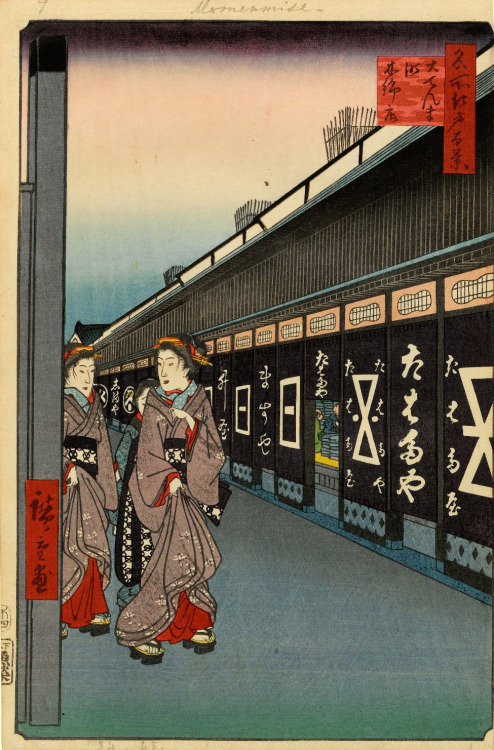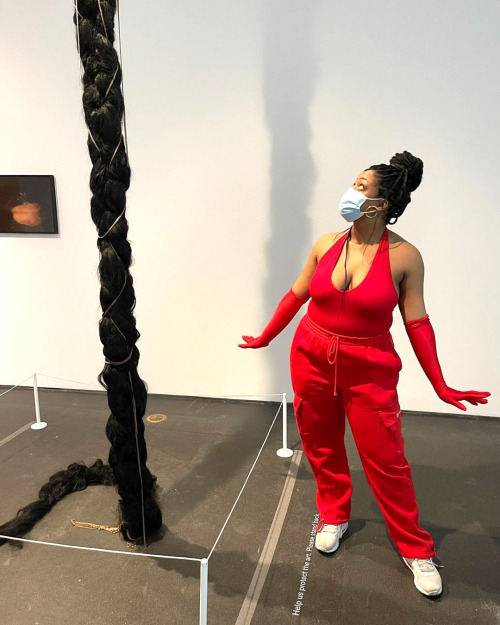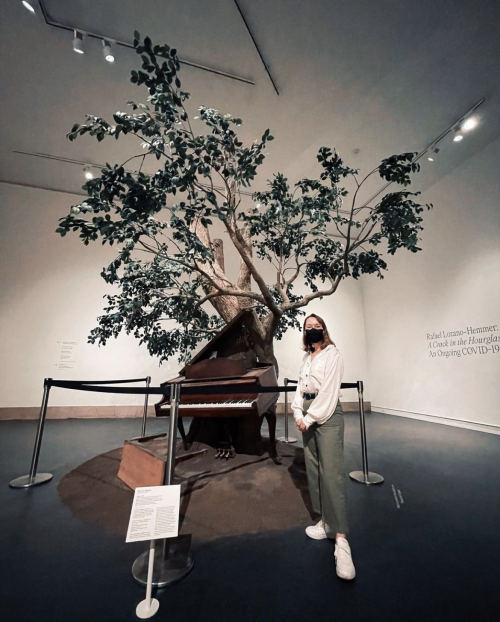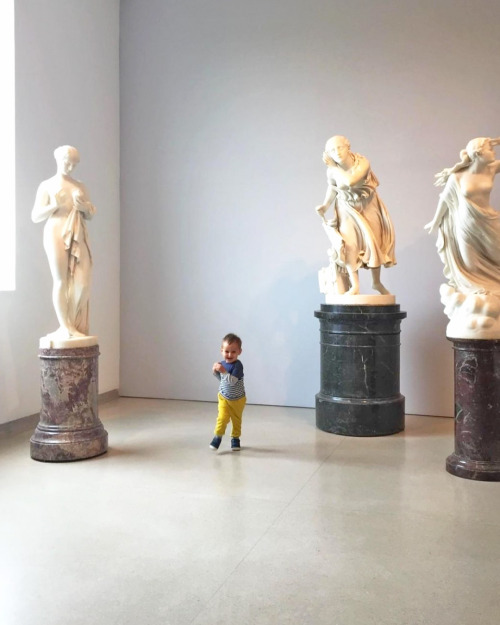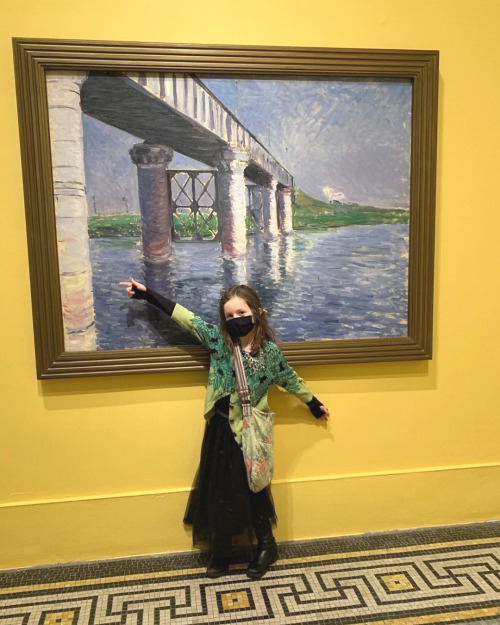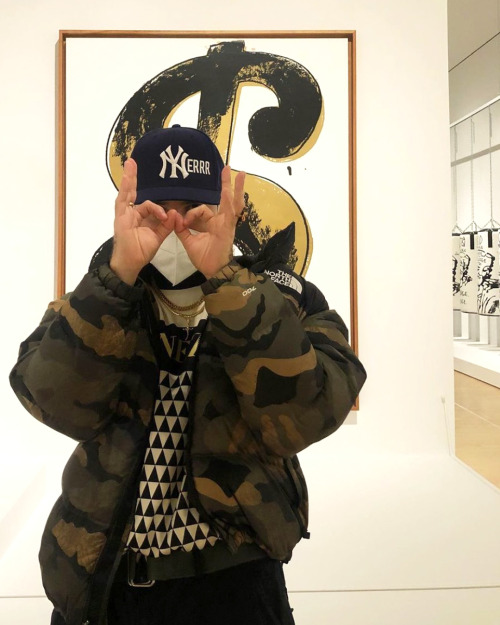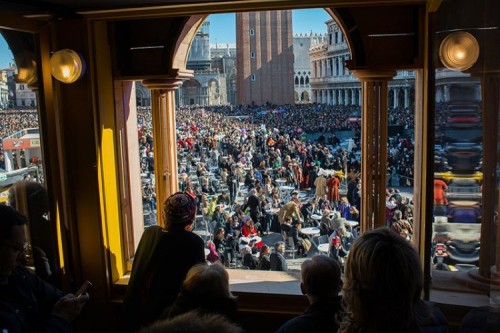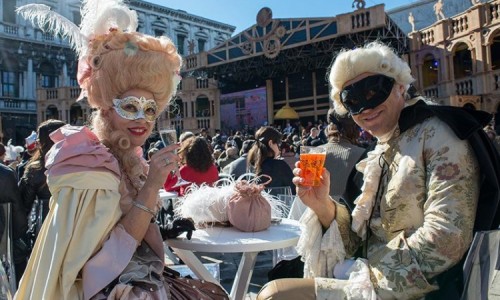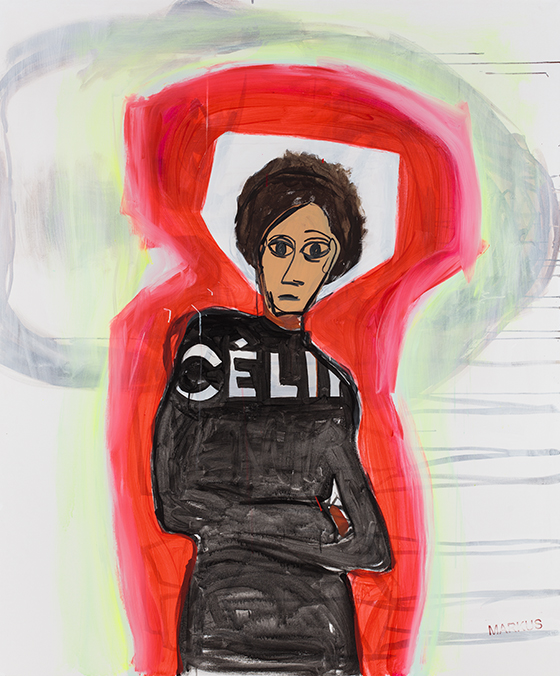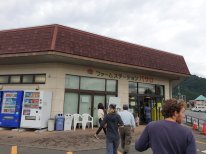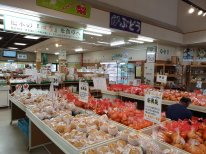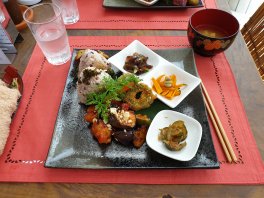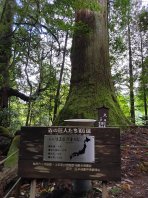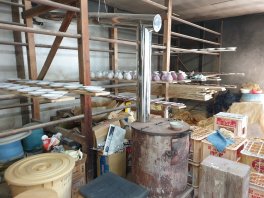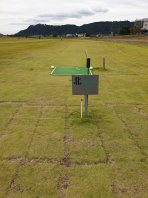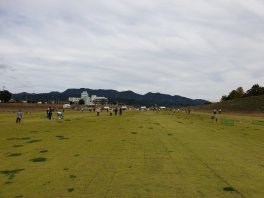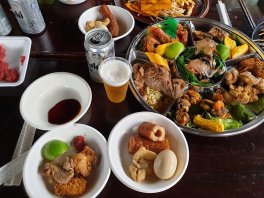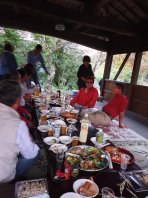#things to do
New Post has been published on https://www.alwayswanderlust.com/where-stay-buenos-aires/
Where To Stay In Buenos Aires | The Best Places and Neighborhoods
Buenos Aires, Argentina
The city-state of Buenos Aires is the capital of Argentina. It’s rich; diverse culture has been shaped by the flow of migrants looking for a better life. Buenos Aires’ residents have come for over 100 years from all over Europe and Russia.
This sprawling metropolis is home to 13 million people spread across 40 diverse neighborhoods or barrios.The buildings and traditions have been stitched together from worldwide influences. European style architecture dominates the city center. When I first landed in Buenos Aires on a flight from Madrid, I thought the plane never left Spain!
Buenos Aires an amazing place to visit and explore. So many places to see and things to do. You’d be hard press to spend only a couple of days exploring this expansive place. You’d need several days or even weeks.
But where to stay in this sprawling metropolis?
There are many neighborhoods and sections of Buenos Aires, and there are many places you pick. There are some neighborhoods I’ve omitted because either the location is too far away from cool stuff to do (and things to see) or simply there are not many options in terms of accommodations like “Retiro” for example.
I’ve also omitted the “La Boca” barrio, though beautiful in the daytime it can get very seedy at night. It’s generally not a good place to be, and it tends to have a higher crime rate than the rest of the city. I’ve picked (and tested) the best places where you can have fun and stay reasonably close to all the tourist attractions, while being safe, in Buenos Aires. You can read all about it below.
The Best Places To Stay In Buenos Aires
I spent about two months in this city. To say it’s huge is an understatement. I’ve stayed in dank hostels in downtown and event rented fancy apartments with the celebrities in Palermo. There are some seedy areas in the city and some very cool places. I’m here to give some insights on where to stay and what to do in those places.
This guide to some of the best neighborhoods will help you to choose the best place for you. A base to set out explore this fascinating city.
Pro Tip: Read my detailed travel guide on Argentina for tips on traveling in the country and how to save time and money.
Microcentro – Where to stay in Buenos Aires for Central Location
This is the corporate heart of the city. During the day, it is busy and lively. At night when the office workers leave, it is quieter. Plenty of restaurants and shopping catering for residents and tourists. There are easy transport links to the bus and rail network. An ideal central location for exploring this vast and fascinating city.
Microcentro, Buenos Aires, Argentina
Find the best places to stay in the Microcentro with our partner, Booking.com
Top 5 Things to Do in the Microcentro
This is Buenos Aire’s cultural and historic district. No doubt, you will find the most iconic architecture in the city. Just walking around the Plaza de Mayo will show you most of the European style buildings of the city.
1 – Walk around the Plaza de Mayo
Go for a stroll and admire the buildings. This is the oldest public square in Buenos Aires. It’s the place where the public have gathered throughout history. The Casa Rosada is the government house. It is also known as the pink house. Guess why! Eva Perón spoke from the balcony in 1940 – an event that is featured in the song Evita.
There is an interesting museum behind Casa Rosada that explores the history of Argentina. It is free to visit. The Cabildo de Buenos Aires houses the national museum. It concentrates on the May Revolution and the fight for independence.
2 – Check out the El Obelisko
A national monument that commemorates the 400th year of the founding of the city. It was erected in 1936 and has recently been cleaned up and restored. It is an impressive 67m high. Stand at its base and marvel at the widest street ever. The Avenida 9 de Julio has so many lanes.
Impressive and slightly terrifying for the pedestrian, but don’t worry, there are lots of people crossing the street towards the Obelisko. The monument is worth checking out at night or dusk when it lights up and displays all its glory.
3 – Tango and Shopping
Browse through the shops in the Florida Mall and enjoy the street performances of Tango. Then visit the Confiteria Ideal, a beautiful building that has starred in many films. Take a tango lesson or join in with a dance party at El Baso on a Friday afternoon.
4 – Visit Two Iconic Buildings
The Palacio Barola is uniquely designed around Dante’s Divine Comedy. It is an office block with 22 floors. To see this remarkable building, you need to book onto a guided tour. A 1920’s elevator takes you from floor to floor. On the roof, there is a lighthouse from which you can see a panoramic view of the city. You may prefer a night tour, which includes a wine tasting.
The Casa de la Cultura has a room – the Salon Dorado, inspired by Versailles. Think gold cherubs and rococo style. This building was commissioned for the La Prensa newspaper. The building is topped by a bronze statue of Pallas Athena – the goddess of wisdom. She represents the freedom of the press. Visit on a Friday evening to enjoy a musical performance.
5 – Kitsch Culture
Take a guided tour of La Botica del Angel, the birthplace of the “café concert.” This was the home of Eduardo Bergara Leumann. He was an actor and TV presenter with a flamboyant style. The interior displays bling at an extreme level. If it glittered, he loved it.
San Telmo – Where to Stay in Buenos Aires on a Budget
This is the oldest barrio in Buenos Aires. The site of the first industrial works in the 17th century. It housed the dockworkers and the brickmakers. It is named after the patron saint of seafarers.
The most multicultural area of the city. The colonial buildings and the cobbled streets echo the lives of past inhabitants. Now the buildings house antique shops, steak houses, cafés, and tango parlors. The area is famous for its murals and pop-up galleries. The Paseo de la Historieta runs through San Telmo, and you can see comical structures throughout.
Budget accommodations are plentiful in San Telmo, so if you’re on a tight budget, I recommend you stay here. There are also lots of places to eat for cheap. There are few luxury hotels, but they do exist in San Telmo. See below.
San Telmo, Buenos Aires, Argentina
Best Accommodations In San Telmo
- Luxury – L’Adresse Hôtel Boutique
- The La Bombonera Stadium is reachable within 1.3 miles of L’Adresse Hôtel Boutique. The place has express check-in and check-out, a bar, non-smoking rooms, and free WiFi throughout.
- 3 or 4 Stars – Bohemia Hotel
- This hotel is situated in the oldest and best-preserved neighborhoods of Buenos Aires and surrounded by bars, tango shows, and shops. Breakfast is served daily.
- Budget-Friendly – Puerto Limon Hostel
- Centrally located in Buenos Aires, Puerto Limon Hostel is a cozy vintage style hostel. There are spacious accommodations with free WiFi access throughout the property. The rooms come with air conditioning, a bathroom, and a flat-screen TV. Shared kitchen and an outdoor area with BBQ facilities are also available.
Top 5 Things to Do in San Telmo
1 – Visit the Plaza Dorrego
ThePlaza Dorrego is the beating heart of San Telmo. A historic square with plenty of bars and cafés. You may be lucky and witness an impromptu tango performance. Or you can visit one of the many milongas (tango parlors) to see the dance that was born here.
On Sunday, the square hosts a sprawling antique fair. Almost 300 stalls crowd together accompanied by street entertainers. In the surrounding streets like Calle Defensa, the stalls offer crafts and unique gifts. If you are looking for clothing, visit Pasaje Guiffra.
2 – Visit the Convento de Santo Domingo
This Dominican convent was built in the 18th Century. The British lay siege to it in the 19th Century. It was turned into a museum when the Dominicans were thrown out. The interior is a beautiful example of the Spanish colonial style. Manuel Belgrano, a national hero, is buried here. A beautiful building a short walk from Plaza Dorrego.
3 – Check out Casa Mínima
This is a small narrow house that was supposedly built by freed slaves. Or gifted to a free slave. It’s a great and charming story that highlights the historic slavery that existed in Buenos Aires and the rest of the world. It is a fascinating little house and worth including in a walk around the historic buildings. Blink, and you may miss it.
4 – Admire the Architecture
Take a breath and look around. The mix of cultures has resulted in some lovely and unusual buildings in various styles. Many of the old colonial houses are now galleries and shops. Look out for the Solar de French. Once the home of a French soldier, now a place to shop. Many quirky artisanal wares.
5 – Museum of Modern Art (MAMBA)
The building was a tobacco warehouse built in the 19th Century. The museum has been recently restored (2010) and contains an impressive amount of Argentine art. Also, work by many modern artists like Salvador Dalí and Henri Matisse.
Palermo – Best Area to stay in Buenos Aires for Nightlife
Palmero is the largest neighborhood in Buenos Aires. Lively and vibrant. Palmero has it all. Historical museums, restaurants, art galleries, and green spaces. It is so large that it is a collection of neighborhoods. Each has its own distinct feel and attractions. This place is also active at night, featuring bars and nightclubs.
If you’re staying in Buenos Aires a little longer than a month, Palermo is your best choice. I recommend you find an apartment rental. My then-girlfriend (wife now) rented an apartment for a month in Palermo. It’s one of the up and comping neighborhoods of Buenos Aires and fairly clean. Outside of this, check out my recommendations for the best accommodations in Palermo.
Palermo, Buenos Aires, Argentina
Best Accommodations In Palermo
- Five Star – BE Jardin Escondido
- Here’s an upscale hotel by Francis Ford Coppola. Luxurious rooms are furnished with upscale decor and equipped with plasma T.V. Alto Palermo Shopping mall is close by.
- 3 or 4 Stars – Soho Point Central
- Located in the trendy Palermo Soho neighborhood. This hotel is just one block from Serrano Square and the many pubs and cafes in the area. The Line D subway station is five blocks away.
- Budget-Friendly – Caravan BA | Hostel Boutique
- Caravan BA | Hostel Boutique has a seasonal outdoor swimming pool, a bar, a lounge, and a garden. Continental and buffet breakfast options are available daily. The property has a 24-hour front desk, a shared kitchen, and a currency exchange for guests.
Top 5 Things to Do in Palermo
1 – Visit the Museums
MALBA – Museo de Arte de Latinoamericano de Buenos Aires. Founded in 2001, it boasts a fabulous collection of Latin American art. Tickets are cheap and start at $2 per person.
Museo Evita – dedicated to the life and impact of Eva Perón
Museo de Arte Popular José Hernández – the collection of the family Blanco. A small museum filled with a collection of religious icons and silver.
2 – Go to the Gardens
Palmero has two notable gardens. A botanic garden and a Japanese garden. Both are an exquisite day walking around fabulous green spaces. There’s a small fee to get into the Japanese garden but well worth it. You can always see this along with other notable attractions via the Hop-on-Hop-off bus.
3 – Take a Walk in the Parks
Parque Tres de Febrero contains the Galileo Galilei Planetarium. There are many other green spaces to enjoy. An impromptu picnic?
4 – Visit the Buenos Aires Eco, Park
This used to be known as the city zoo. It still retains the collection of animals.
5 – Food Culture
The Argentine meat platter is impressive. Most restaurants serve this grilled dish. La Cacrera is well-known for this dish.
The Plaza Serrano is the place to go for cocktails and drinks. If you want a view of the ocean with your favorite drink, then head to the historic Club de Pescadores.
For shopping and food, visit Palmera Hollywood with its fashion stores and upmarket restaurants.
Recoleta – Where to Stay in Buenos Aires for the First Time
A wealthy barriowith upmarket boutiques and exclusive schools. It’s famous for its buildings. The former palaces and townhouses are in the fine art style. A quiet walk in the early morning or late afternoon will let you experience how it resembles Paris.
If it’s your first time in Buenos Aires, this would be your ideal place because it will have most of its famous tourist attractions within walking distance. Buenos Aires is a big city, but I walked from neighborhood to neighborhood without exhausting myself. It’s a pedestrian-friendly city.
Recoleta, Buenos Aires, Argentina
Best Accommodations In Recoleta
- Five Star – Alvear Palace Hotel
- The Hotel has 192 guestrooms and suites decorated in a modern French style. Renovated top floors show off 15 spacious suites. Alvear Suite and higher categories provide exclusive service, where a team of butlers assists guests, making their stay a memorable experience.
- 3 or 4 Stars – Hotel Etoile
- Hotel Etoile offers elegant well-lit suites overlooking the charming French-style Recoleta Gardens, 2,950 feet from 9 de Julio Avenue, and 1.1 mi from Florida Pedestrian Street. Guests can enjoy the fine cheese and wine bar and taste Argentinean meat at the on-site restaurant. WiFi is free in all areas of the hotel.
- Budget-Friendly – La Bamba Hostel
- WiFi is provided throughout the property. La Bamba Student Hostel is a 19-minute walk from Recoleta Cemetery and one mile from Museo Nacional de Bellas Artes. The Colon Theater is 1.1 miles, and the Obelisk is 1.5 miles. A shared kitchen, a shared lounge, and currency exchange are available for guests.
Top 5 Things to Do in the Recoleta
Outside of the famed cemetery with the same name, the Recoleta neighborhood is full of colorful things to do. There’s a shopping mall and a movie theater right next to the cemetery if you get tired of looking at tombs.
1 – Visit Recoleta Cemetery
This strange and beautiful graveyard dates back to 1822.
All the graves are above ground and are ornately decorated.
The building styles are an eclectic mix of ancient, modern, and quirky.
There are at least 6,400 graves.
Each one a marvel. It’s worth taking a tour to learn about some of the fascinating people buried here.
Famously Eva Perón, twenty years after her death.
Every grave has its own tale to tell. Not just the high-status ones.
Open 8:00 am, and the gates close at 6:00 pm.
2 – Check out a Bookshop and a Library
One of the 12 largest bookshops in the world. The fabulous El Atenceo Grand Splendid is worth a visit. Not just for books but for the building. It began in 1919 as a theatre. A short spell as a cinema. Now an exquisite bookshop. You can drink a cup of coffee while listening to the piano player. Admire the sumptuous theatrical décor. Red velvet drapes and fresco ceilings provide the opulent backdrop to the rows and rows of books.
The National Library of Argentina is built in the brutalist style. It is built on the grounds of the demolished Unzué Palace. This was the residency of President Juan Perón and his wife, Eva. The reading room on the fifth floor has a spectacular view. You will need identification to gain access to the library. The library has close to a million historical documents, some of which date back to the 16th century. A fascinating glimpse of past lives and troubles.
3 – Get a Dose of Culture
At not one but three museums.
TheMuseo Nacional de Bellas Artes houses art by Titian, Goya, and Rembrandt.
TheMuseo Nacional de Arte Decorativohas period furniture, silver, and some exquisite Zubov miniatures from Russia.
TheCentro Cultural Recoleta has sculptures, interactive exhibits, events, and workshops.
4 – Visit the Parque Thays
Enjoy a walk around the sculptures. The park was named after Carlos Thays – a French landscape architect. He designed many of the green spaces around the city. Look out for the impressive sculpture by the Columbian artist Fernando Botero – the nude male torso (Torso Masculino Desnudo). As well as Marta Minujín’s United Nations statue and many others.
Stroll through Calle Junín to see some of the wonderful former palaces like Palacio Duhau and Pizzurno Palace.
5 – It’s time to Shop
At the weekend, make time to visit the Feria de Artesanos de Plaza Francia.The 150 plus stands offer a wide range of high-quality handcrafted goods. At a substantial discount to the same goods gound in the upscale shops. A festive atmosphere is provided by a range of street performers. Plenty and varied street food to enjoy as you decide what to buy. Or just soak up the atmosphere. All kinds of traditional and modern items made from silver, leather, and ceramics.
Need a coffee break? Then head to the year-old Café La Biela. Serving its customers for 150 years. You can sip your coffee on the terrace shaded from the sun by a giant rubber tree. The name means ‘connecting-rod.’ Once, it was the meeting place for racing car champions. The interior is decorated with motoring memorabilia. The café is recognized as a Place of Cultural Interest.
Puerto Madero – Where to Stay in Buenos Aires for the New Trendy
This was once a run-down dockland. It has been refreshed through a decade of regeneration. This is a quiet and safe place to visit. Celebrated architects like Santiago Calatrava have contributed to the transformation.
This place is surrounded by modern high-rises yet close to the historic district. There are many waterfront restaurants, and if you happen to be there during New Year, there’s the fireworks show.
Puerto Madero, Buenos Aires, Argentina
Find the best places to stay in Puerto Madero with our partner, Booking.com
Top 5 Things to Do in Puerto Madero
Puerto Madero is a hip hang out. There are lots of modern structures and top-notch restaurants throughout. It’s a perfect place for a late-night stroll.
1 – Burque Museo Corbeta A.R.A “Uruguay”
This nautical museum is close to the Sarmiento. This ship is a corvette. You can find out about its history from the exhibitions and items displayed inside. It had an interesting working life that included a rescue mission to Antarctica as well as naval battles.
2 – Buque Museo Fragata Sarmiento
You can explore the ship and take that perfect Instagram photo from the deck. A view of the Buenos Aires skyline. You are standing on a ship that has been six times around the world. It was built in 1890. Only ever used as a training ship.
3 – Walk over Puente de la Mujer
The bridge designed by Calatrava. A fantastic blend of engineering prowess and art. Based on the idea of a couple dancing the tango. The bridge swings 90° to allow ships to pass up the river. Keep an eye out, especially if you’re there on the holidays for spectacular fireworks!
4 – Visit the Costanera Sur Ecological Reserve
The best way to see this giant park is by bike. There are many hire shops. You can explore a variety of habitats from forest to lagoons. Enjoy a stroll along the ocean’s edge. This is a free attraction.
5 – Visit El Zanjón
In 1536 this was the first settlement of what was to grow into Buenos Aires. A large Mansion was constructed here in the 19th Century. Some of the original structures were destroyed in the process. Tourists can now explore the site as a collage of different times. Colonial buildings alongside a ruined mansion.
Villa Crespo – The Coolest Place to Stay in Buenos Aires
This is a district that manages to balance being modern and traditional. This is the barriowith a large Jewish population. Take a stroll around the streets, and you will come across historic synagogues.
Villa Crespo, Buenos Aires, Argentina
Find the best places to stay in Villa Crespo with our partner, Booking.com
Top 5 Things to Do in Villa Crespo
1 – Shop for Leather Goods
Murillo is both the traditional and current center for the craft of worked leather. You will find many shops covering any item that can be made out of leather. If you have the time, you can have a custom made item to fit you.
2 – Enjoy Dining
A multicultural community with a varied range of restaurants. Sample Jewish dishes at La Crespo. Try middle eastern cuisine at Sarkis. If you’re a meat-eater, you’ll be in heaven!
Argentina has some of the best beef in the world. Definitely go for the Argentine Parilla.
3 – Parque Centenario
A circular park covering 12 hectares. Plenty to do and see. The park contains the Bernardino Rivadavia Argentine Museum of Natural Science. It is open every afternoon until 7 pm. For festivals and events, visit the Eva Peron Amphitheatre.
At the edges of the park, you will find an assortment of stalls. A book fair all week and a weekend market.
4 – Explore the Streets
As well as the buildings, you can admire the art. Villa Crespo is famed for its murals. Buenos Aires is acknowledged as one of the top cities for urban art. They can be seen all over the area, but there are some spectacular examples at the crossroads of Castillo and Serrano. You can take an organized tour to seek out the hidden gems. This is free art on a giant colorful scale.
5 – Enjoy a Night Out
Visit Club Silencio for cocktails while you watch a performance. You begin the experience with a blindfold and are led through a sensory musical experience. This club is based on the David Lynch club of the same name in Paris. Or you can go to Villa Malcolm for cheap wine and tango dancing. Café San Bernardo offers pool, dancing, and your drink of choice.
Belgrano – The best Neighborhood in Buenos Aires for Families
In this friendly neighborhood, you can see old Anglo-Saxon style family houses mixed together with sleek, high-rise apartment blocks. There are two things to watch and listen for while walking around the sidewalks.
The unique dialect that is a mixture of Spanish and German. It’s called Belgranodeutsch. The other is the dog walkers. They have masses of dogs. There is a rule that there is a maximum of ten dogs per person. This is often ignored with people walking twice that number.
Belgrano, Buenos Aires, Argentina
Find the best places to stay in Belgrano with our partner, Booking.com
Top 5 Things to Do in Belgrano
1 – Go Shopping for Clothes
This is the area for fashionistas. The shops are centered around Avenida Cabildo. You can get anything from top designers down to fast fashion.
2 – Barrancas de Belgrano
There are many green spaces across Buenos Aires. In Belgrano, the park is designed by the French-Argentine architect Carlos Thay. It was created by moving a river by building an artificial embankment. Over 60 different varieties of trees and plants grow here. It is a pleasant green space to relax in the midst of the city.
There are many sculptures to enjoy as you stroll around. Most famously a replica of the Statue of Liberty. It was made by Frédéric Bartholdi. The same creator as the iconic statue.
In the evening you can watch tango dancers at the bandstand.
3 – Visit a Museum
There are two museums. The Larreta Museum is housed in the former home of the Argentine writer Enrique Larreta. Inside there are exhibits of his modern art collection. His love for Spain is reflected in the exhibits and the beautiful tiled floors. Outside, the garden is laid out in the Andalusian style.
The Historical Museum Sarmiento was once the town hall. It is built in the style of an Italian townhouse. The museum covers Argentine history. You can take a guided tour, and there is a museum gift shop.
4 – Visit River Plate Stadium
This is the largest stadium in Argentina. It is the venue for most of the international football matches played in this country. Depending on your preference you can watch a football match or a concert. Or you can visit the sports museum on the site. At 3,500 square feet, it is the largest museum dedicated to sporting achievement in the World. The stadium sits in the Estuary of the Rio de la Plata. The silver river, but the English mistranslated it as a plate. The Argentine name for the stadium is Estadio Monumental.
5 – Walk Around the Streets
If you are passing the Inmaculada Conceptión Church in the afternoon, you may be lucky enough to see a bright and colorful wedding party. The building itself is beautiful. It is built in a round shape and has a lovely interior and an interesting history.
After you have enjoyed the architecture, make sure you end up in the Barrio Chino – China Town. You enter through an ornate stone archway. Here you can enjoy the noodle bars and street food. But you can also sit down in a high-end restaurant to enjoy the very best oriental cuisine. Around February, you may be fortunate enough to see the Chinese New Year celebrations. Plenty of shops selling a mixture of oriental goods.
The Best Accommodation In Buenos Aires?
Are you looking for the best hotels in Buenos Aires, regardless of the location? Don’t have the time to look at the various neighborhoods and barrios? Here are my top picks for hotels and other accommodations in Buenos Aires!
If you want the best views in Buenos Aires, there can be none better than the Hotel Panamerico! The top floor lounge is reserved for guests only, and you won’t be able to get the insane view of the Avenida 9 de Julio with the Obelisko unless you book a room in the hotel. It’s rated at 4.5 Stars, so it’s not exactly friendly if you’re in a tight budget.
I think the view with all the photos I was able to get is well worth it. I think I paid just a hair over $100 a night, but the photos I got from the top are priceless. Just click on the link of this page to get the best deals in rooms.
This post contains affiliate links from Booking.com or similar. It costs nothing to you should you purchase or book from our affiliate links.
Will we see you at the Brooklyn Artists Ball After Party on April 12?
Get your ticket to Brooklyn’s hottest party hosted by our Young Leadership Council featuring a DJ set by Swizz Beatz, special performances, and artist-led activations. You dress your best and we’ll handle the complimentary wine and beer.
Get your ticket at the link below. Members receive a discount on all ticket levels.
In his most famous works of the 1960s, Warhol often lifted imagery from newspaper ads. In the 1980s, he returned to this source, drawing from spiritual advertisements but varying his approach by tracing the ads by hand.
The images include a Jesus Christ night-light, a reference to the book of Revelation’s apocalyptic mark of the beast, admonitions for good behavior in consideration of the afterlife, and a radiant star of psychic power. The question “ARE YOU DIFFERENT?” may indicate Warhol’s personal insecurities, or how his sexuality had marked him throughout his life.
Have you experienced #WarholRevelation yet? Bring a friend and grab a ticket: https://bit.ly/revelationbkm
Visitors at Andy Warhol: Revelation. Brooklyn Museum November 19, 2021–June 19, 2022. (Photo: Jonathan Dorado, Brooklyn Museum. Artworks by Andy Warhol © 2021 The Andy Warhol Foundation for the Visual Arts, Inc. / Licensed by Artists Rights Society (ARS), New York. Used with permission of @warholfoundation) #warholfoundation
Post link
One is a wanderer, two is company, and up to ten is a group tour at the Museum.
Whether you’re bringing your family from out of town, a crew of colleagues, or a few friends, there’s a tour for you! Led by a team of art historians and educators, our group tours are available for many of our exciting collections as well as our special exhibitions. Experience our galleries together and discuss art with a focus on NYC history, female artists, Ancient Egyptian art, identity and representation, and more.
Group tours accommodate up to ten people and last about an hour and fifteen minutes. Get more information on pricing and availability: https://bit.ly/3qscSSE
Utagawa Hiroshige (Ando) (Japanese, 1797-1858). Cotton-Goods Lane, Odenma-cho, No. 7 in One Hundred Famous Views of Edo, 4th month of 1858. Woodblock print. Brooklyn Museum, Gift of Anna Ferris, 30.1478.7
Post link
At long last… First Saturdays are coming back!
Join us on April 2 from 5-10 pm for the return of one of our borough’s most beloved events celebrating culture, community and the excellence of Brooklyn. We’re excited to share a dynamic lineup honoring the continued fight for Black liberation with special guests, including:
- Isa Reyes
- Bathe
- The Layout
- Mel Chin
- Anastacia-Renée Tolbert
- Quincy Scott Jones
- Cynthia Manick
Along with this incredible line-up, you can also see #WarholRevelation for 40% off during the span of the event!
First Saturdays are free, but advance registration is required. Admission is subject to capacity at the time of registered visitors’ arrival and is first come, first served. RSVP today at bit.ly/3qcIPy6
Glee all through the galleries.
If you’re heading to the Museum this weekend, be sure to capture your joy or strike a pose and share it with us by using #MyBkM.
Take a look at what’s currently on view and which events are around the corner: https://bit.ly/3hiILZx
(on Instagram) @epmoody, @skyy.forcer, @billythefnkid, @danverhey, @michaelsshome, @vivisternick, @__________rav, @doule28
Post link
On March 31, International Transgender Day of Visibility, join us for a screening of the documentary “My Name Is Pauli Murray,” a portrait of the groundbreaking attorney, activist, priest, and dedicated memoirist — told largely in Murray’s own words.
Derrick T. Jordan, Director of the Ackerman Institute’s Gender & Family Project, begins the screening with ways to support trans youth amidst the legislative attacks on rights to affirming healthcare. After the film, director Julie Cohen and Dr. Kimberly Springer, curator of the Oral History Archives at Columbia University’s Rare Book & Manuscript Library, discuss Rev. Dr. Pauli Murray’s profound legacy in developing intersectional legal theory and overcoming gender barriers to be ordained as an Episcopal priest.
We hope to see you there! Tickets are $16 ($14 for Members).
Courtesy of Amazon Studios
Post link
I’ve promised to post these a few weeks back but forgot, good portion of what makes farming and collection of ingredients fun is actually being able to do something with them, in case of Cloud Meadow that means preparing a meal out of them.
This here is just a basic set of some of the dishes and drinks you can prepare with the produce.
Post link
Every season, the CFA calendar from Wesleyan University is full of exhibits and musical performances that are so intriguing. I try to make it to at least one concert, but honestly, I could see something every month. They put together a fantastic program of professionals, alumni, staff, and students, and I’m lucky enough to live close enough to head to Middletown after a…
- take a walk through nature.i find this to be very relaxing, especially when you’re walking paths that you never walked before. you keep spotting new things and can be alone with your mind for a minute
- read a book. especially after studying, this is a good way to let your mind rest a bit. you can sit at home and make it as cozy as possible
- photograph. this way you can appreciate the details nature has to offer, whilst also being quite busy with getting the right angle and things like that
- write something. try to build a world, and make it your own with the rules and characters you want. this is also a great way to escape reality. you can also let your deepest thoughts out without getting judged
- put on some music. do i even need to explain this one?
@skratchpad HOUSTON! brought to you by Mega DJ Store & DJ Nos & Skratchpad Houston residents! Official launch Tuesday July 16!!
Post link
um! havent posted in a hot sec! im good btw, will return to regularly scheduled posting soon
EXPECTATION:

REALITY:

Happy World UFO Day! If you’re looking for close encounters, these three Wisconsin UFO festivals are a great place to start.
Post link
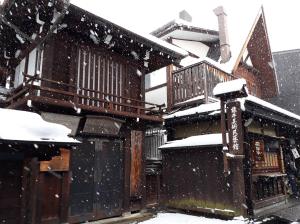
NHK travel featured an episode about this lovely small ‘water’ town in Gifu prefecture. The journey to Gujo-hachiman was something that I’ve always wanted to try – hopping on to a small local train that passes by mountains and rivers to the countryside.
At the end of the year 2017, I flew to Osaka and hung there for a day or two before continuing my trip to Nagoya. Since my destinations were kind…

I travelled around Kyushu for a month, covering all the prefectures except Okinawa. During this period, my main mode of transport between each prefecture was bus. Something that did not occur to me until my WWOOF host shared with me that travelling by bus might be more convenient and cheaper than train. Typically, travelling by bus is cheaper, more convenient with less transfer and also,…
I’ve been wanting to try farming for the longest time ever. There’s a few places I had in mind. Australia and New Zealand for fruits, Italy and France for vineyard, Japan for tea and rice. In the end, I chose Japan for a few reasons but mainly to improve my Japanese.
As this is my first time and I’m not sure if I will like it, I’ve decided to try a short gig. I searched online for platforms that could connect me with hosting farmers and WWOOF was the top search. After reviewing feedback, looking at the hosts, type of work available and reading blogs, I’ve decided to trust WWOOF and registered as a member. WWOOF doesn’t have a main central website. To WWOOF in Japan, you need to register on the WWOOF Japan website. Their headquarters is in Hokkaido. To apply as a member (WWoofer), there is a yearly fee of 5,500 yen via paypal.
Before I applied as a WWoofer, I was browsing the host list and looking for hosts and jobs that I am interested in. I was hoping to try tea farming but surprisingly, it was rather difficult to find a host that does that. I settled for fruits and rice instead because I’m not a fan of animal husbandry. You can easily find a host by area that you like. I was looking around either Chiba, Shizuoka or Fukuoka area. I ended up shortlisting two in Fukuoka and wrote in to one first, and if I didn’t get any response in the next few days, I’ll write in to another. In the message, I asked if I can WWOOF from 15 Oct to 28 Oct 2019. I wrote in English and Japanese (with some help from Google) just in case. I messaged the host 1.5 months before because I needed some confirmation before booking my flight.
Turns out, I was really lucky that the host that I wrote to checked his WWOOF mail everyday and I got a reply the next day. I guess it helps to check if the WWOOF host is active by reading the host profile. For example, some of them will update they are urgently looking for WWoofer or they are not looking for WWoofer. My WWOOF host (h2792 embed link) told me that he can take me in on those dates. He also told me that in order to obtain his contact information, I had to click on the ‘Request Contact Information’ link at the top of the host profile page. After that my host disclosed his contact information. The contact information will disappear in one week, so remember to note it down! Nearer to the date, we used the same platform (WWOOF message) to contact each other.
Pre-farming logistics
- Register as a member (WWOOFer) on WWOOF Japan
- Decide on the host and message them using WWOOF message and let them know the dates you wish to commit to (and how many people).
- You will usually receive an email notification that you have WWOOF message and go to WWOOF Japan website to check. It is best to check the website message inbox everyday just in case.
- Once your host replies and accepts your dates, click on the ‘Request Contact Information’ link at the top of the host profile page.
- Your host will share his/her contact information. Remember to note it down as the contact information will disappear in one week.
- Remember to print your WWoofer permit as you will need to give the hardcopy to your host. Click on ‘WWoofer Permit’ on the left menu bar. Please also bring the identification that you registered (e.g. if you register using your passport as identification, you will need to show your passport to the host for verification).
Fast forward to my 1 month trip to Japan. I planned to farm for 2 weeks and explore around Kyushu in the next 2 weeks. Thank god I went with Fukuoka in the end because Typhoon Hagibis hit Japan and most of the regions were affected except for Kyushu region. Chiba was probably one of the worst hit areas. My flight wasn’t cancelled and I landed in Fukuoka on 13 Oct. I contacted my host on WWOOF Japan website one day before to arrange for pick up (because in the contact information, it was mentioned that he can meet at the bus station or the train station). I stayed 2 nights in Fukuoka City before taking a train to Kurume to explore a little then take another local train to Chikugo Ooishi to meet my host. My host is working, so he could only meet me after 5pm.
I got off the train, probably the only person to alight at this stop because it’s the country after all. Most people drive or in fact, take the expressway bus that is faster and more convenient (I learnt about the expressway bus from my host and it became my main mode of transport when I travel around Kyushu). My host, Hayashi-san along with 2 other WWoofers from France met me at the train station. Hayashi-san drove us back to his house and I was shown to my room. My room is a Japanese tatami room and there is a small table, laundry rack and futon for me to sleep on. Preliminaries, I gave Hayashi-san my WWoofer permit and showed my passport as verification and Hayashi-san explained to me the expectations and schedule. We talked for a bit as well, getting to know each other, Hayashi-san is an experienced WWOOF host of 12 years and had 300 over WWoofers in this duration.
Here’s the schedule from Monday to Saturday:
0700: Wake up and get ready for breakfast
0800 – 1200: Work (teatime usually at 10am for 30mins)
1200 – 1300: Lunch
1300 – 1700: Work (teatime usually at 3pm for 30mins)
1900: Dinner
Sunday is my break but 3 meals are provided at the same time as well.
After Hayashi-san showed me around the house and settled in, at around 7+pm, Hayashi-san told us that dinner was ready. We went to the kitchen and everyone had dinner. It was really delicious, the meals were prepared by Hayashi-san’s daughter-in-law, Maho-san. There’s three generations in this house for meals, Hayashi-san and his wife, son, daughter-in-law and granddaughter. We each have our own utensils for food and there’s master utensils on the dishes as well. My fellow French WWoofers were really nice too. They have been WWoofing for 10 months on a 1 year working holiday visa. They are a couple and one of them spoke really good Japanese. I felt relieved knowing that as time went by, her Japanese improved because like me, she learnt Japanese back in France but when she first arrived in Japan, she couldn’t really speak and understand. It also helped that our host family only speaks Japanese, so we are forced to learn. But not to be afraid, even if you don’t understand Japanese, it is fine. Hayashi-san and his family are very nice and they would either try to simplify the Japanese for us or gestures do help as well. Or you might be lucky like me to meet fellow WWoofers who can speak and understand some Japanese. But it is true, I managed to speak better than I did back home because I am in an environment where I have to listen, understand and speak Japanese everyday for 2 weeks that gradually, I am a bit more comfortable and confident with the language.
Day 1
The next morning, I woke up early at 6.20am to get ready. I was freezing in the middle of the night not sleeping under the futon. At 7am, the morning community announcement began. It’s really interesting to hear that, where promptly, they will announce 3 times, one in the morning at 7am, one in the afternoon at 12pm and one in the evening at 7pm. Mostly to give news highlights, community updates and weather updates. We had breakfast at around 7+am where Hayashi-san’s wife prepared for us and after that, at 8am, we started work.
We went to the workroom across the house and started organising and cleaning the workroom. Our task for the day is to weigh and sort the pears that were harvested yesterday. I brought my own work gloves to the farm because on the profile, I saw that I’ll need to bring a few items like gloves, raincoats and rubber boots. I was a little worried about the rubber boots but turns out I could borrow gloves, coats and boots from the farm. However, I strongly advise bringing 2 sets of gloves in case of wet weather, because we had to experience wearing wet gloves for work and it wasn’t the most comfortable feeling ever.
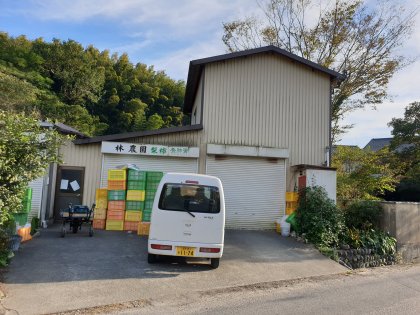
Hence, my first farm work commenced. To sort the pears by weight, there is a machine to do it. First, at the other side of the machine, Hayashi-san added the respective stone weight, then, he started the machine and started putting each pear on the scale. As the pear moves across the machine, it measures the weight, it is the same, it drops down to the relevant slot. We on the other side of the machine will collect them and place them in the crate. The tough part is to carry and stack the crates because it’s heavy AF. Surprisingly, this requires stamina because the machine is going relatively fast and we had to constantly shift things around. At 10am, we stopped work for tea time. We sat on crates and around the table to have hot tea, snacks and pear. Hayashi-san peeled the skin and cut the pears for us. The pears were super sweet and juicy. It was a half an hour break and we learned more about each other and culture while we ate.
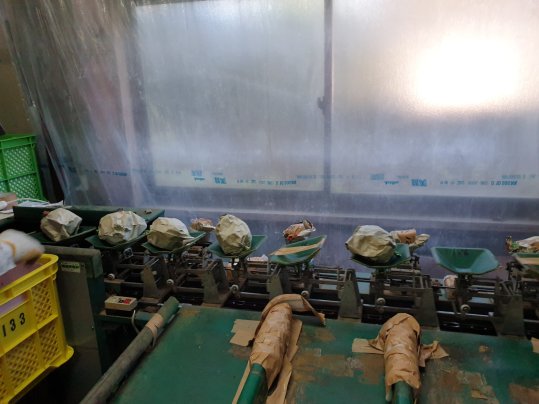
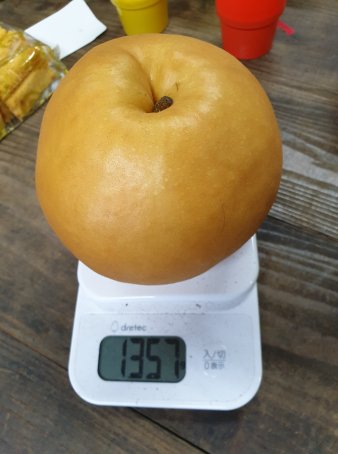
10.30am, we went back to sort the pear. Once sorting is done, we removed the pear wrappers and cut the stem and placed it back to the crate. I learnt that they wrapped the pears while it is growing to prevent the crows from eating it. While working, we listened to the radio Hayashi-san tuned in to and occasionally, conversed while we work. This goes on until 12pm where we went back to the house for lunch. We rested for a while until Hayashi-san called us for lunch and we went to the kitchen to eat the food Maho-san (Hayashi-san’s daughter-in-law) prepared for us. After lunch, we went back to our room to rest until 1pm where we headed back to the workroom to continue working on the pears. At 3pm, it’s tea time and again, we sat on crates and drank tea, ate snacks and pears. 30 minutes up, we went back to work until 5pm. Seigo-san (Hayashi-san’s son) told us we can go and gave us a drink which was their product. Kabosu juice. Really refreshing.
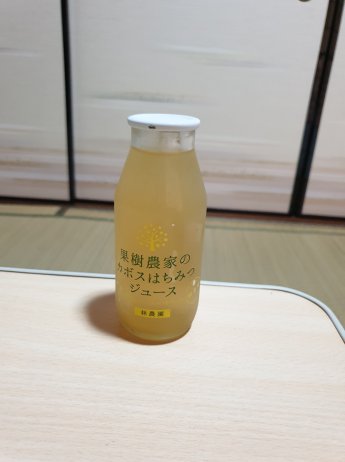
First day was tiring for me because I don’t exercise at all and stacking crates of pears was super challenging for me as I lack the strength. Nonetheless, I didn’t think it was boring and rather enjoyed the work. We went back to the house where we can do whatever we want until Hayashi-san called us at around 7plus pm for dinner. Dinner was prepared by Maho-san as well and there’s always many dishes including leftovers. What I loved the most is that the Japanese don’t like to waste food. We ate leftovers for days until it finished. For all meals, we usually ate with Hayashi-san and his family, hence there were interactions every time. After dinner, we are back to our room to rest. I was really tired and could start to feel the soreness in my muscles, knowing too well that the next day will be really tough.
Day 2
Similarly, I woke up at 6.20am, still freezing because I was dumb enough not to sleep under the futon. But this time, I wore long pants and sweater to sleep so it wasn’t as bad as the first night. And true enough, my muscles were sore AF. After our 7+am breakfast, Hayashi-san drove us to the rice field. Our job today was to harvest rice. We were in our normal shoes, clothes and gloves. To the field, Hayashi-san taught us how to harvest the rice. Using the sickle, we cut the rice crop which was later placed on a machine to remove the husk from the crop. We were asked to harvest three-quarters of the field first because kindergarten children from Fukuoka will be coming over for field trips and they will try to harvest the rice crop as well. At 10am, we sat in the field and had our tea. There was a persimmon tree there and we plucked a few persimmons for our snack. Just like the pear, these persimmons were super sweet and juicy.
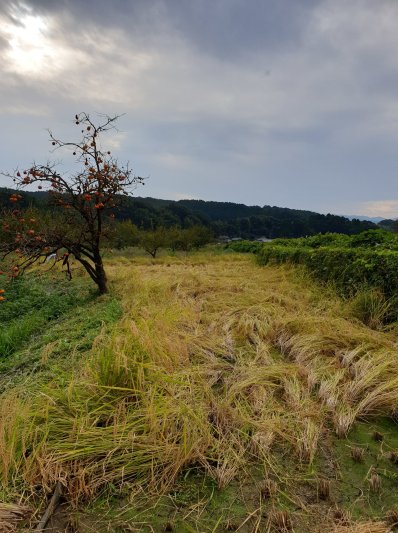
From a distance, we could hear the kids walking towards the field. Hayashi-san’s son, Seigo-san taught the kids how to harvest the rice. They took turns to try and while waiting, some of the kids were distracted by Hayashi-san, who was fixing the machine while others were busy looking at insects. They were pretty fascinated by us because we don’t look Japanese. One kid asked me if I could touch insects. To be honest, I am not a fan of insects, but when fully clothed, I could co-exist in an outdoor field. The weather wasn’t really doing great, it started drizzling and after the kids left for the pear field, we resumed work, harvesting all the rice crop. These rice were actually used to make mochi. By the time we finished, and tied the straws, it was raining pretty heavily and we went back to the house for lunch.
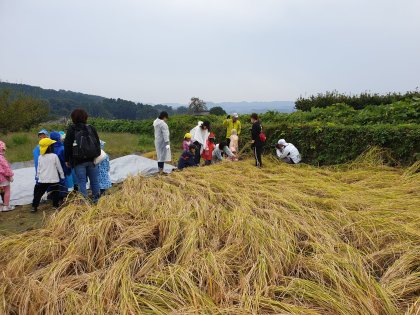
After lunch and break, we went back to the workroom to finish up our task from yesterday. One of the workers, Chi-san came in to help, we had tea at 3pm. After tea time, we were geared up, covered with raincoats, pants and boots. Off to the pear farm to harvest some pears in the wet weather. We loaded empty crates on the back of the truck and Hayashi-san drove me to the farm while both Camilles followed Chi-san in her car.
At the pear farm, we transported the empty crates on the tractor to the end of the farm, then hung basket around us and began plucking pears from the trees to our baskets and once that’s full, placed them in the crate. I thought it was as simple as just plucking pear off the stem but I was told to be careful and how to pluck the pears from the trees as new pears will grow from the stems. As it was still raining, it was a bit uncomfortable, where water will fall on us when we harvest and with the humidity, there were tons of mosquitoes. Harvesting the pears was also tricky because we need to follow the branches from respective trees. After collecting around 20 crates of pears, we transported them back to the farm and called it a day. Harvesting pears is definitely an easier task than sorting them.
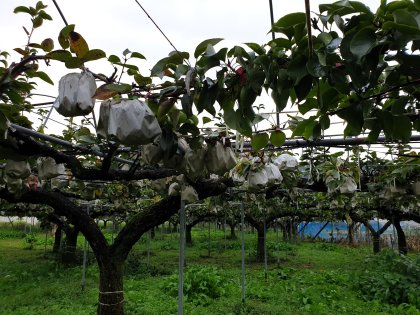
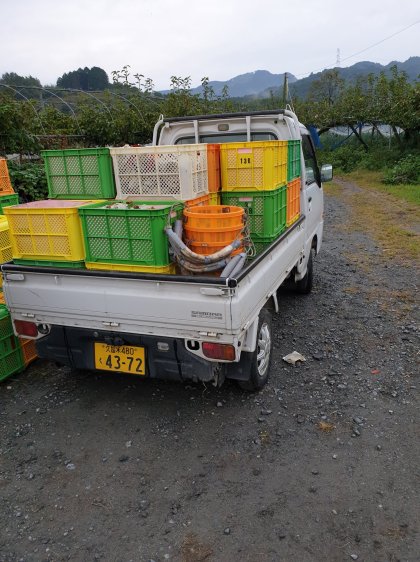
Dinner as usual was great, and we usually gained more knowledge about Japan, culture and food from dinner conversation. Hayashi-san offered some homemade umeshu and it was really nice! Their family don’t really drink alcohol, so I was a great help to finish the umeshu.
Day 3
The next day after breakfast, we went back to the workroom to sort the pears. After lunch, Hayashi-san drove us to the farmers’ market to have a look. There, we saw various products and there were pears from the Hayashi farm there as well.
Hayashi-san then drove us up to the mountain to sight-see. After looking at the scenery and taking photos, he drove us to the next destination, the community centre where they are getting ready to exhibit their work. Hayashi-san is part of the photography club and there is an exhibition where members exhibit the photos they took. The gym was divided into two sections so that one is for the photography club and the other is for the calligraphy club. The photography club members were really friendly and we were talking afterwards. There was a lady who could write kanji names really nicely and all the members were asking her to help them write theirs. I chimed in and asked if she could write mine too.
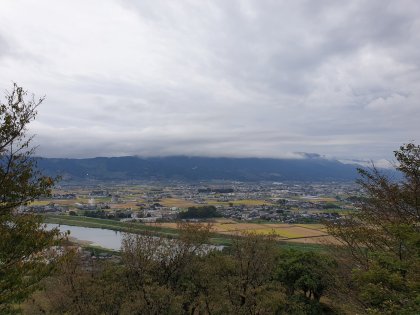
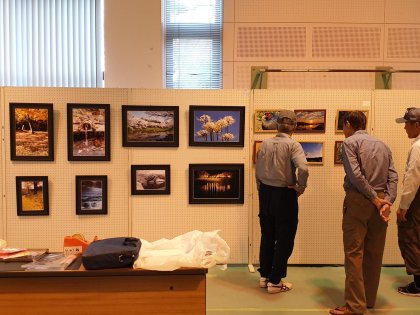
We hung at the photography club for 1.5 hours and I thought that was probably the end. Turns out we were not going back, Hayashi-san drove us to Asakura where there is a famous park, Kunishiseki Hiratsuka Kawazoe Iseki Park, however, the park was closed. Hayashi-san then drove us to the Kirin Beer Factory where it is in season the cosmos field is in full bloom. He dropped by a 7-11 to buy umbrellas first as the weather was pretty bad. Upon arriving at the field, we could see that there were two huge fields of cosmos and we were trying to take photos in the rain.
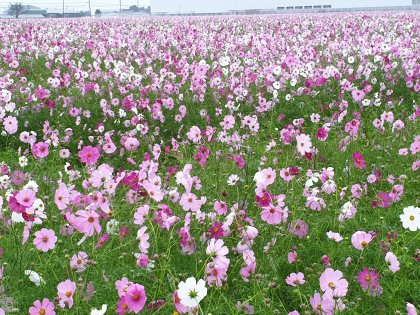
I’ve decided to go to the onsen next door after having been attacked by mosquitoes, hoping the hot water will relieve the itch. The onsen fee is 500 yen but Hayashi-san gave us free tickets to the onsen and without further ado, I walked next door with an umbrella and my clothes.
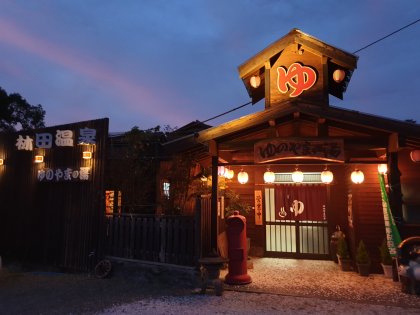
I gave the ticket to the owner of the onsen who’s really friendly and before entering, I asked her if there’s shampoo in the onsen. She said there isn’t and I went back to the house to take all my essentials. Went back to the onsen and she asked me to take my time. This is my second onsen experience. I was lucky the first onsen, I had it to myself. But this time round, there were people in the onsen. What I found really funny or interesting was that people talk to each other naked. So this old lady was wearing her clothes while I was preparing to take off mine and she started talking to me and asking me about the weather if it was still raining outside and if it is huge that requires an umbrella. Being polite, I replied to her until she was done and left.
Then I was ready to go in when a lady came out of the onsen, greeted me and told me to take my time. So I guess it’s just manners where the locals greet each other and tell each other to take their time to enjoy the onsen. It is customary to not wear clothes in the onsen area and it is important to bathe first before entering the onsen. There’s soap at the bathing area. After showering, I went into the indoor onsen. Inside, ladies were talking to each other and I went to the corner of the onsen. I asked if I could go to the outdoor onsen and they told me I can and where it was. I went outdoors and enjoyed the onsen alone. After a while, Camille joined me at the outdoor onsen and we chatted, learning more about her other WWOOF-ing experience and work.
After a hard day of work and muscle ache, a soak in the onsen proves to be a really great choice. I finally understood why in the game, Harvest Moon, there’s onsen that could relieve fatigue after farming. Dinner was amazing. Japanese curry rice and because it’s the season, Maho-san added pears to the curry which made it sweet and flavorful.
Day 4
The next day, we went to the field to harvest. This time round, Camille brought mosquito repellent along and offered me to use it. We spent the morning harvesting crates of pears and after that, Hayashi-san drove us out to Oita for lunch. Apparently, Hayashi-san knows the owner and it has a really nice ambience to it. Biko Oita Cafe & Space. Hayashi-san treats us to the Japanese set, which comes with salad, miso soup and the main consists of meat, vege and onigiri. It was such a huge serving that I forced it down, NO FOOD WASTE! We finished with a cup of organic coffee which surprisingly, wasn’t as bitter as I thought.
After lunch, Hayashi-san brought us to sight-see around, we went to this forest where trees were really old and afterwards, he drove us to a ceramic workroom where he bought us tea cups as gifts.
Oita is on the other side of the mountain from the place we are at, and the drive between mountains and fields with the window open was really refreshing. We were back to the pear fields to harvest more pears for the rest of the day. However, that was not all, after transporting the harvested pears to the workroom, Hayashi-san drove us to the town to catch the sunset. We were taking photos and timelapse videos but the view was pretty magnificent.
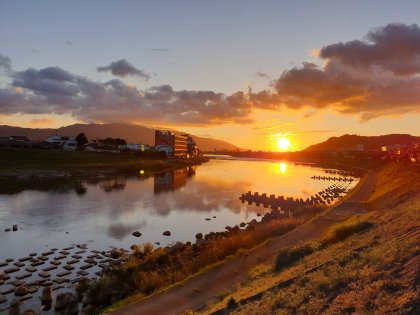
Back at the house, I did my laundry and hung them outside, hoping they will be dry by Monday.
Day 5
On Sunday, it was my rest day and also Camilles’ last day. I truly enjoyed their company and couldn’t have asked for a better WWOOF mates. I’ve gained a lot of knowledge from our conversations and really admire them for WWOOF-ing around for 1 year. After parting ways, I borrowed a bicycle from Hayashi-san and rode to the town. First thing on the list is to the drug store. I wanted to get mosquito repellent but couldn’t find it. It’s the season where everyone was buying that there’s no more stock. Since I am back to civilisation, I bought some drinks and materials that I can write on. I continued to explore around and the weather was turning rather warm. Got myself an ice-cream from the convenient store and continued cycling around until it was around lunch time that I cycled back to the house. Lunch was provided on Sunday as well. Hayashi-san joined me at lunch and asked if I am interested in playing golf. Apparently there’s a park golf game that he is going to participate in and invited me to join.
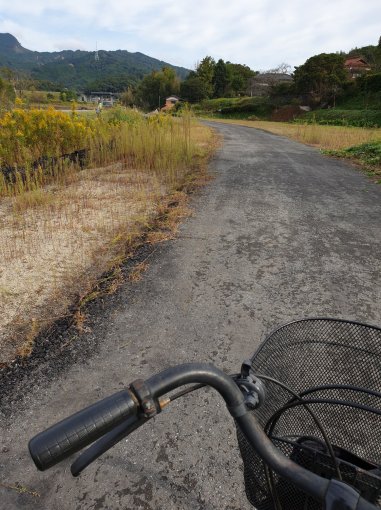
After lunch, he drove to the park and it was really crowded. There is a competition going on and there were probably 12 teams of 4 playing. I joined a team where I met Nashi-san, Yasuie-san and another younger guy who’s name I forgot. Of course I was the worst player scoring 90 points. The higher your score, the worse you fare. But it was a really fun moment. Yasuie-san even bought me drinks. After the match, the winners received prizes and participants got drinks and tissue paper. Yasuie-san even gave me the prize that she won (mostly snacks). Really cute. But everyone was so friendly and inclusive. I also met Hayashi-san’s cousin, Hajime-san.
Back to the house, I thought that was the end. I took a short break and was thinking if I should cycle to town again. Was about to head outside when Hayashi-san invited me to another place. We walked across his house to another house. Behind that house is a pavilion and people were laying out food. Apparently it was a feast probably to celebrate the harvest season. I had my first horse sashimi. Kyushu-ben was really difficult to understand but I had a great time mingling with everyone. They kept pouring alcohol for me but I am gamed for it. Hayashi-san’s cousin was also really cute and friendly. She was the one who made sure I was looked after. Their hospitality really touched me.
After the feast, which was essentially dinner, I went to the onsen for another soak. After onsen, I went back to the room where I swapped room to Camille’s room as another WWOOFer will be joining in the next few days.
Day 6
Breakfast was prepared by Maho-san and after breakfast, we went to the workroom to separate pears for juice and those to sell. Sakuragi-san, a friend of Hayashi-san came to help out this morning. We had snacks tea and snacks at 10am. The snacks were really nice, brown sugar snacks from Okinawa. We continued sorting our pears and went back to the house for lunch at 12pm.
It was sorting of pears that we harvested after lunch, cutting the stems and placing them in the crate. We ate the famous Fukuoka snack that is usually for souvenirs, Hakata torimon. Back to doing the same work until 5pm. In between, the captain whom I met yesterday at the feast came over and said hi. He’s so funny and jovial, calling me “shachou” – president. Ha.
Day 7
Sleeping under the futon was really a game changer that I survived 13 degrees celsius feeling warm at times. This morning, after breakfast, we went to the workroom to unwrap and put the pears into the crates. It was just Hayashi-san, Sakuragi-san and I. Chi-san joined us after tea time. Lunch today was yakisoba and they were so good.
After lunch, Hayashi-san drove us up to the mountain by van to harvest kabosu. It’s a bit like citrus/lime/calamansi. There were so many spider webs and insects in the kabosu field. I teamed up with Chi-san, while she cuts fruit from the tree, I picked them up. We harvested 8 crates of kabosu and I think pears were so much easier to harvest. We had our tea time on the mountain before heading back to the workroom to finish up with the pears. The journey up and down the mountain was kind of bumpy and I was surprised I didn’t get motion sickness, probably because the window was opened. In general, the view was really serene and beautiful.

Being a person who is utterly terrified of change, having to relinquish my normal daily routine due to Covid-19 has been a huge strain on my mental health. Here in Malta, we are currently experiencing partial lockdown: all flights have been cancelled, schools, restaurants, pubs, coffeeshops and many other miscellaneous shops are closed and many people (including doctors and nurses) are in…
Oooh. So pretty!
I want marks like this. I imagine I’ll have to be a brave little toaster and handle lots of stingy warm-up before the caning even starts. And then handle someone winding up and going hard on my ass. Restraints and a gag will probably be in order, even if we do it at a playspace.
The cruel reality of marks like this are that you can only get them with NO warm-up. A good warm-up reddens and swells the whole area and the distinct contrast of the cane mark is lost. You will have to be very, very brave to get these marks. Good luck and have fun!
I had gotten a different impression from my partner who gave me the most pretty marks, MLAM. The warm-up wasn’t for me to be less uncomfortable/in less pain when the real hitting came, it was to get the blood to the surface and prime the area for bruising.
Perhaps the techniques for leaving distinct cane marks could be different than the techniques for leaving lots of bruising, although I did get plenty of nice and distinct paddle marks. Thank you for sharing this, though! I almost prefer no warm-up sometimes. The pain from the actual impacts is awful, but I really hate the slapping warm-up. The impacts can come one, then some waiting time, another, some waiting time, etc, but the slapping is just constant stinginess.
I think I’ll need to test this out. Have someone give one buttock a nice warm-up, and nothing for the other, and then have them hit me equally hard with the cane on both sides.
For science!
Post link
some very cottagecore things to do during quarantine:
embroider old clothes
make your own soap or candles
bake pressed flower shortbread cookies
learn about foraging and edible plants
read/write poetry
make spore prints
learn to knit or crochet
make your own tea
put on your most grandma-esque outfit and do a little cleaning, maybe sweep away cobwebs!
bake bread
watch or read the secret garden
tea-stain paper and fold origami hearts with little messages for friends
create a playlist for a loved one
plant wildlife-friendly flowers
write letters and seal them with candlewax
start a flower-pressing scrapbook
write a song
make a moodboard
host a teddy bear picnic
make nature-inspired earrings
build a birdhouse or bug hotel
take a bath with candles, a homemade bath milk (see white rabbit skincare’s recipe for vegan bath milk!), and petals
make a flower crown
watch adventure time or ghibli films!
most important of all, take care of yourself. wash your face in the morning. get dressed. change your sheets. be gentle and patient. stay safe<3



















